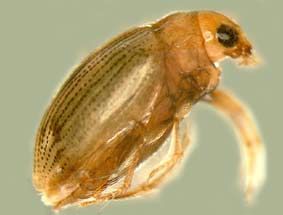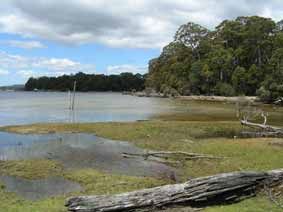Major Group: Insecta
Order: Coleoptera
Family: Haliplidae
Genus: Haliplus
This family is represented in Australia by a single genus, Haliplus.
|
Descriptive Features:
Adults
antennae entirely or almost entirely glabrous
prothorax with pair of notopleural sutures separating notum from externally visible pleuron on each side
elytra with large punctures forming regular rows
abdomen with ventrite 1 divided into 2 or 3 parts by hind coxae
metasternum with distinct transverse suture
mesocoxal cavities open laterally
metacoxae extending laterally to meet elytra, so that junction of metepimera and first ventrite is not visible,
metacoxae with very large plates concealing basal ventrites and most of the hind femora
tarsi 5-segmented
size: 1.7 - 4.1mm
Larvae
antennae shorter than head width
maxillary palp 3-segmented
mandibles broad at base and narrow at apex, with internal perforation
labrum completely fused to head capsule
labial palps 2-segmented
abdominal tergum 8 subterminal, not forming spiracular siphon or spiracular chamber
tergum 9 without paired urogomphi
abdominal segment 10 much longer than 9, without hooks, at apex
legs 6-segmented, including pretarsus (claws)
size:
|

|
Haliplus larva |
|
|

|
Haliplus adult |
|
Taxonomic Checklist: Species
Haliplus alastairi Watts
Haliplus australis Clark
Haliplus bistriatus Wehncke
Haliplus ferruginipes Regimbart
Haliplus fortescueensis Watts & McRae
Haliplus fuscatus Clark
Haliplus gibbus Clark
Haliplus halsei Watts & McRae
Haliplus hydei Van Vondel
Haliplus pilbaraensis Watts & McRae
Haliplus pinderi Watts & McRae
Haliplus oberthuri Van Vondel
Haliplus signatipennis Regimbart
Haliplus sindus Watts
Haliplus stepheni Watts
Haliplus storeyi Van Vondel
Haliplus testudo Clark
Haliplus timmsi Van Vondel
Haliplus wattsi Van Vondel
|
|
Distribution: Vic, SA, WA, Tas, E Qld, NT, E NSW, Rottnest Island
Sensitivity Rating: SIGNAL grade 2
Functional Feeding Group: shredders, macrophyte piercers, possibly some adults are predators
|

|
Lake St Clair in Cradle Mountain-Lake St Clair NP, Tas |
|
|
Ecology: Instream habitat: Adults and larvae of Haliplidae are found amongst aquatic vegetation in ponds and lakes or in slow flowing areas of rivers and creeks. In the Northern Hemisphere, adults are only encountered outside of water during dispersal flights, after pupation or when environmental conditions become unfavourable.
Feeding ecology: Adults and larvae are herbivore shredders and piercers. Adults feed on various types of green algae, although some adults have also been reported feeding on insect larvae. Larvae feed on algae and other plant material with some larvae able to suck algal cells or plant tissue through perforations in their mandibles.
Habit: Commonly known as ‘crawling water beetles’, adults crawl along the bottom because they are poor swimmers, using alternate leg movements. They may also walk on land and are capable of flying. Adults breathe surface air, storing it in the sub-elytral cavity and between the metacoxal plates. This air storage allows adults to spend a long time under water. Adult haliplid beetles are attracted to light.
Life history: In northern Australia and southern areas with a ‘Mediterranean climate’, Haliplidae species are strongly seasonal with adults emerging when the wet season or winter is well underway. In permanent waters of eastern Australia adults appear to be less seasonal. Eggs are attached to host plants or are embedded within plant tissue after first biting a hole in the leaf or stem. Hatching is followed by three larval instars. Final instar larvae leave the water to pupate in damp soil at the edge of water. It is possible that adult haliplid beetles over winter underwater.
|
| |
Information Sources: Watts & McCrae 2010, Watts 2002, Watts 1988b, Lawrence & Britton 1991, Lawrence et al. 2002b, Van Vondel 2004, Mathews 1980, Williams 1980, Gooderham & Tsyrlin 2002, Jach 1998
Key to Species: Van Vondel 1995 (adults)
Watts & McCrae 2010 (adults, Pilbara WA)
|
|
|
|